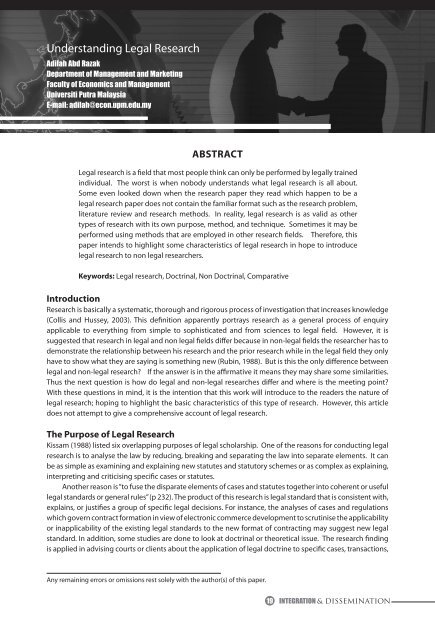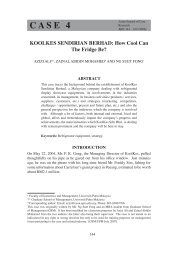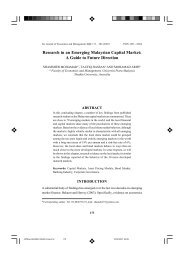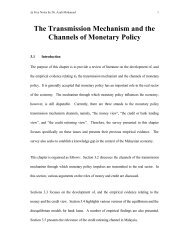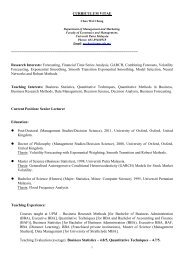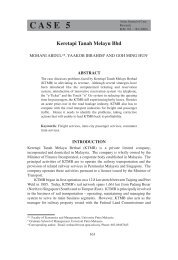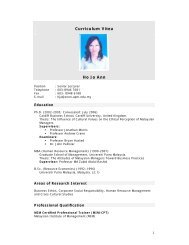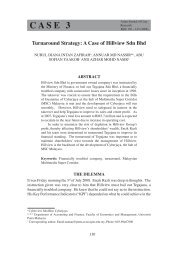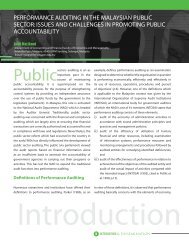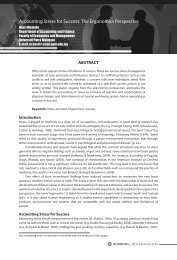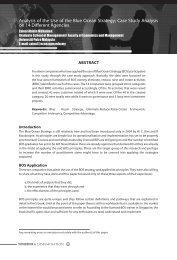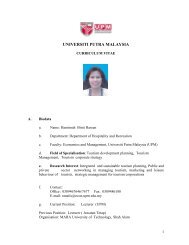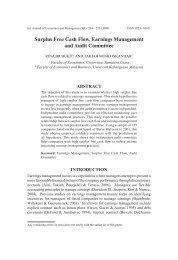Understanding Legal Research - Universiti Putra Malaysia
Understanding Legal Research - Universiti Putra Malaysia
Understanding Legal Research - Universiti Putra Malaysia
Create successful ePaper yourself
Turn your PDF publications into a flip-book with our unique Google optimized e-Paper software.
<strong>Understanding</strong> <strong>Legal</strong> <strong>Research</strong><br />
Adilah Abd Razak<br />
Department of Management and Marketing<br />
Faculty of Economics and Management<br />
<strong>Universiti</strong> <strong>Putra</strong> <strong>Malaysia</strong><br />
E-mail: adilah@econ.upm.edu.my<br />
Abstract<br />
<strong>Legal</strong> research is a field that most people think can only be performed by legally trained<br />
individual. The worst is when nobody understands what legal research is all about.<br />
Some even looked down when the research paper they read which happen to be a<br />
legal research paper does not contain the familiar format such as the research problem,<br />
literature review and research methods. In reality, legal research is as valid as other<br />
types of research with its own purpose, method, and technique. Sometimes it may be<br />
performed using methods that are employed in other research fields. Therefore, this<br />
paper intends to highlight some characteristics of legal research in hope to introduce<br />
legal research to non legal researchers.<br />
Keywords: <strong>Legal</strong> research, Doctrinal, Non Doctrinal, Comparative<br />
Introduction<br />
<strong>Research</strong> is basically a systematic, thorough and rigorous process of investigation that increases knowledge<br />
(Collis and Hussey, 2003). This definition apparently portrays research as a general process of enquiry<br />
applicable to everything from simple to sophisticated and from sciences to legal field. However, it is<br />
suggested that research in legal and non legal fields differ because in non-legal fields the researcher has to<br />
demonstrate the relationship between his research and the prior research while in the legal field they only<br />
have to show what they are saying is something new (Rubin, 1988). But is this the only difference between<br />
legal and non-legal research? If the answer is in the affirmative it means they may share some similarities.<br />
Thus the next question is how do legal and non-legal researches differ and where is the meeting point?<br />
With these questions in mind, it is the intention that this work will introduce to the readers the nature of<br />
legal research; hoping to highlight the basic characteristics of this type of research. However, this article<br />
does not attempt to give a comprehensive account of legal research.<br />
The Purpose of <strong>Legal</strong> <strong>Research</strong><br />
Kissam (1988) listed six overlapping purposes of legal scholarship. One of the reasons for conducting legal<br />
research is to analyse the law by reducing, breaking and separating the law into separate elements. It can<br />
be as simple as examining and explaining new statutes and statutory schemes or as complex as explaining,<br />
interpreting and criticising specific cases or statutes.<br />
Another reason is “to fuse the disparate elements of cases and statutes together into coherent or useful<br />
legal standards or general rules” (p 232). The product of this research is legal standard that is consistent with,<br />
explains, or justifies a group of specific legal decisions. For instance, the analyses of cases and regulations<br />
which govern contract formation in view of electronic commerce development to scrutinise the applicability<br />
or inapplicability of the existing legal standards to the new format of contracting may suggest new legal<br />
standard. In addition, some studies are done to look at doctrinal or theoretical issue. The research finding<br />
is applied in advising courts or clients about the application of legal doctrine to specific cases, transactions,<br />
Any remaining errors or omissions rest solely with the author(s) of this paper.<br />
19<br />
INTEGRATION & DISSEMINATION
or other legal events (p.234). It may also criticise judicial opinions and in case of conflicts between the<br />
decisions of different court, suggests the resolution to those conflicts.<br />
Furthermore, legal research can also be performed by scholars who wanted to provide teaching<br />
materials for students. The end products include books and modules. Similarly, some scholars performed<br />
legal research to understand the legal doctrine and the law as it is. To achieve this objective the researcher<br />
examines the causes, the consequence and the interpretation of the relevant legal doctrine and legal<br />
practices in its social context. The result of the research highlights among others the practical usefulness of<br />
the law and the significance or insignificance of any given theory.<br />
Finally, the last reason for doing legal research is to acquire an understanding of the legal subject while<br />
arguing for a better way of doing things. A researcher who performs this type of research critics and<br />
comments legal doctrine and practices from the perspective of different sciences likes economics, politics<br />
and sociology.<br />
The Format of <strong>Research</strong><br />
McConville and Wing (2007) divided legal research into doctrinal and non-doctrinal research. Non-doctrinal<br />
research can be qualitative or quantitative while doctrinal is qualitative since it does not involve statistical<br />
analysis of the data. Both types of research may overlap. There is also a third format of legal research which<br />
consists of either doctrinal or non-doctrinal or a combination of both performed using a comparative legal<br />
method.<br />
Doctrinal <strong>Research</strong><br />
Doctrinal research asks what the law is on a particular issue. It is concerned with analysis of the legal<br />
doctrine and how it has been developed and applied. This type of research is also known as pure theoretical<br />
research. It consists of either a simple research directed at finding a specific statement of the law or a more<br />
complex and in depth analysis of legal reasoning (McConville and Wing, 2007).<br />
<strong>Research</strong>ers who dwelt in this type of research are concerned with the philosophy of law and the topics<br />
involve are restricted. They mostly focus on the nature of law and legal authority; the theories behind<br />
particular substantive areas of law, such as torts or contracts; and the nature of rights, justice and political<br />
authority. Others may study the legal decision making process, and the theories of legal interpretation<br />
and legal reasoning (Gordon, 2008). An example of a pure theoretical work is found in The Principles of<br />
Justice by Wright (2000). In this article the researcher examined the concept of justice by looking into the<br />
distributive and corrective theories of justice. Meanwhile, in Implying Good Faith in Contracts: Some Recent<br />
Developments, Shaikh (1993) examined the application of the good faith principle in <strong>Malaysia</strong>n Contract<br />
Law.<br />
Some researchers use this approach to study legal doctrine and the underlying theory behind the<br />
doctrine. In A Corrective Justice Theory of Antitrust Regulation, (Robertson, 2000), the author focused on<br />
the use of classical corrective justice principles as an explanation for per se rules that categorically prohibit<br />
concerted and unilateral business activity that unfairly injures economic competitors. Meanwhile,<br />
Spector (2006) in his work Promises, Commitments, and the Foundations of Contract Law: A Contractarian<br />
Approach to Unconscionability, concentrated on the freedom of contract theory and the rules that govern<br />
the unconscionability of a contract. Finally, Chahil (2005) examined the application of the natural law<br />
theory in the <strong>Malaysia</strong>n Constitution in the Relationship between Natural Rights Theory and the Doctrine of<br />
Constitutionalism Encapsulated within the Federal Constitution.<br />
Non-doctrinal <strong>Research</strong><br />
Non-doctrinal research, also known as socio-legal research is a legal research that employs methods taken<br />
from other disciplines to generate empirical data to answer research questions. It can be a problem, policy<br />
or law reform based. Non-doctrinal legal research can be qualitative or quantitative. Doctrinal and nondoctrinal<br />
research could be part of a large scale project (McConville and Wing, 2007).<br />
Non-doctrinal approach allows the researcher to perform inter disciplinary research where he analyses<br />
law from the perspective of other sciences and employs these sciences in the formulation of the law. For<br />
INTEGRATION & DISSEMINATION 20
example, a work by Becher (2007) on Behavioral Science and Consumer Standard Form Contract examined the<br />
psychological phenomena that contribute to (i) consumers’ tendency not to read standard form contract,<br />
(ii) consumers’ inability to correctly evaluate contract terms once they do read them; and (iii) sellers’ ability<br />
to manipulate consumers.<br />
Because non-doctrinal legal research uses empirical data, it provides vital insights into the law<br />
in context, i.e. how the law works in the real world. Empirical legal research is valuable in revealing and<br />
explaining the practices and procedures of legal, regulatory, redress and dispute resolution systems<br />
and the impact of legal phenomena on a range of social institutions, business and citizens (Genn, et al,<br />
2006). Similarly, an empirical research in law and economics applies legal analysis, statistical inference and<br />
economic modelling to fundamental areas of national and international law such as tort liability, property,<br />
contracts, criminal law, law enforcement and litigation. An earlier work which used economics analysis of<br />
the law is a work by Posner (1972) on A Theory of Negligence. In this work Posner developed a theory “to<br />
explain the social function of negligence concept and of the fault system of accident liability…”. He then<br />
tested the theory on a sample of more than 1,528 of the United States appellate decisions from 1875-<br />
1905.<br />
Another example is the work of Landes and Posner (2001) on Harmless Error in which the researchers<br />
developed an economic model of harmless error and tested the implication of the model against some<br />
rules governing reversible and nonreversible error of criminal convictions. The researchers collected and<br />
analysed data from 963 appellate decisions in which the majority opinion discussed harmless error to<br />
identify the impact of different type of errors on the appellate courts’ decisions.<br />
Finally, there is a work by Lim (2007), on Copyright under Siege: an Economic Analysis of the Essential<br />
Facilities Doctrine and the Compulsory Licensing of Copyrighted Works. Lim looked into copyrights law and<br />
its impact on competition. In particular, he examined whether compulsory licensing through the essential<br />
facilities doctrine of competition law provides an acceptable solution to the potential problem of copyright<br />
owner harming competition in the software and database industries by refusing access to copyrighted<br />
work.<br />
Comparative <strong>Research</strong><br />
The third research format is comparative legal research. This format is used to study legislative texts,<br />
jurisprudence and also legal doctrines, particularly of foreign laws. It stimulates awareness of the cultural<br />
and social characters of the law and provides a unique understanding of the way law develops and works<br />
in different cultures (Walker, 1981). It also facilitates better understanding of the functions of the rules<br />
and principles of laws and involves the exploration of detailed knowledge of law of other countries to<br />
understand them, to preserve them, or to trace their evolution (Palmer, 2005). Accordingly, comparative<br />
legal research is beneficial in a legal development process where modification, amendment, and changes<br />
to the law are required.<br />
The most common comparative legal scholarship is cross jurisdictions comparison of laws of different<br />
legal systems. It is typical for researchers who undertake this research to examine the law as it is while at<br />
the same time provide ideas and views for future legal development.<br />
Kierkegaard, (2007) in E- Contract Formation: U.S. and EU Perspective, for instance, examined the rules<br />
applicable to the formation of electronic contracts in the United States and the European Union. Another<br />
example is found in Pure Economic Loss in Europe (Bussani and Palmer, 2003) where a group of researchers<br />
took a painstaking task of comparing laws governing pure economic loss in 13 different legal systems<br />
across the European Union. Nowadays, comparative approach also refers to the study of specific aspects of<br />
the law from the perspective of Shari’ah in comparison to civil law.<br />
The <strong>Research</strong> Design<br />
<strong>Legal</strong> research is descriptive, explanatory or exploratory depending on the research aims, objectives<br />
and many other factors (McConville and Wing, 2007). Descriptive analysis of law sets forth the facts, the<br />
holdings, and the courts’ analysis of a case, or of a series of cases in a given subject area, without attempting<br />
to offer an independent explanation of why the courts decided the cases as they did. It is the study of the<br />
21<br />
INTEGRATION & DISSEMINATION
law as it is. The question of why the law is like this or that is answered using the explanatory design as the<br />
finding can explain the reason for some occurrences and interpreting cause and effect (McConville and<br />
Wing, 2007).<br />
Exploratory research on the other hand aims at gaining general information for the purpose of<br />
defining the research topic, operationalising or explaining variables or aspects of the topic, or generating<br />
hypotheses (Sarantakos, 1998). Exploratory research is useful if the researcher intends to gather preliminary<br />
information to define problems and suggest hypotheses (Kotler et al., 2006). For example, a researcher may<br />
perform an exploratory research to describe and evaluate child protection law in a given jurisdiction over<br />
a certain period of time. Since exploratory research suggests directions for additional research the work<br />
could be a background for a larger research on the relationship between child protection law and social<br />
changes.<br />
The <strong>Research</strong> Process<br />
<strong>Legal</strong> research process is unique. Although the researcher begins his work by finding the research question<br />
which he wishes to study, the process at the later stage is distinctive to legal research. Having found the<br />
research question the researcher selects bibliographic databases to identify secondary sources which could<br />
be anything from text books, bar review, scholarly articles and legal encyclopaedias. Secondary sources<br />
are important in legal research because they point the researcher to primary sources of the law namely<br />
legislations and cases. Secondary sources also reveal current development in the respective area of law,<br />
hence may have instigated the research in the very first place.<br />
In legal research the data are screened to differentiate the most authoritative from the least authoritative<br />
based on either the quality or relevancy of the data to the research issue (McConville and Wing, 2007). To be<br />
able to grade the data the researcher must analyse the legislations to understand its meaning and also the<br />
judicial decisions to derive the principle(s) of law.<br />
A researcher involves in doctrinal research must study the law in details. Due to the uniqueness of the<br />
statutes, the analytical method applied in legal research relies on specific interpretation methods namely<br />
the mischief, literal and golden rules. These rules assign to the words of the statutes their true meaning.<br />
Literal rule allows the statutory word to be interpreted by considering its dictionary meanings<br />
supplemented by basic rules of grammar (Kon Fatt Kiew v PP [1935] MLJ 239). Therefore, if the words of a<br />
statute are clear, they must be followed, even though they lead to a manifest absurdity.<br />
On the other hand, golden rule is used to interpret the words of the statute by modifying the grammatical<br />
and ordinary sense of the words. The purpose is to avoid absurdity and inconsistency. It begins with finding<br />
the ordinary meaning of the language in its textual context followed by finding by clear indication whether<br />
the words used have permissible meaning other than the ordinary. (Re Advocate [1964] MLJ 1)<br />
Finally, when there is need, the rules are interpreted by using the mischief, rule which construes the<br />
words of the statute to suppress the mischief, and advance the remedy that the legislature intended to create<br />
(Lim Moh Joo v PP [1970] 2 MLJ 113). This rule produces a purposive approach to statutory interpretation;<br />
an approach which looks at the reason the legislation was passed by the legislator to assign meaning to<br />
the respective provision (United Hokkien Cemetries, Penang v Majlis Perbandaran, P Pinang [1979] 2 MLJ 121).<br />
For instance, in case of ambiguity the words in the Consumer Protection Act 1999 would be interpreted by<br />
considering that it was enacted as a consumer protection statute.<br />
Other than legislations, cases must also be analysed. The process requires the researcher to carefully<br />
study the facts of the cases and the reason(s) behind courts’ decisions to identify the legal principles applied<br />
by the courts in reaching to their decisions. (In legal terminology the reason given by the court in its decision<br />
is known as ratio decidendi). Although the issues raised in a particular case may be identical to previous<br />
cases, every case is unique. Therefore, the facts of each different case may lead to different decisions. To<br />
have a valid finding, the researcher must be able to identify the similarities and differences of the facts<br />
of different cases. More importantly, he should be able to understand and appreciate the impact of the<br />
distinctive facts of the cases on the principle(s) applied by the courts in arriving at particular decisions.<br />
Having completed the statutory and case analysis, the researcher is now able to answer his research<br />
question(s). Because the finding is supported by authoritative data - data gathered from appropriate<br />
INTEGRATION & DISSEMINATION 22
sources, and analysed by using appropriate methods and technique, the answer to each research question<br />
produces a valid finding. The above process is replicated in non-doctrinal legal research, though of limited<br />
scale. Because non-doctrinal research also involves an examination of a specific legal rule, it is necessary<br />
for the researcher to find primary source of the law. However, having found the law, he can perform all the<br />
other steps used in non legal research without the need to interpret the rules or analyse the legal principles<br />
in details. Interestingly, in non-doctrinal legal research, the bulk of the research process involves method<br />
and technique used in fields other than law, hence, knowledge of and experience with those methods and<br />
techniques are required.<br />
Conclusion<br />
“Assume differences until similarity is proved” is the gist of this paper. This paper has explored the nature of<br />
legal research and its distinctive character compares to the other fields of research. While showing its unique<br />
character, the paper had also highlighted some similarities between a legal and non-legal research.<br />
References<br />
Becher, S. I. (2007) Behavioral Science and Consumer Standard Form Contracts. Louisiana Law Review,<br />
68:117-179.<br />
Bussani, M and Palmer, V.V. (2003) Pure Economic Loss in Europe, Cambridge University Press: Cambridge<br />
Chalil, S. K. (2005) Natural Rights Theory and the Doctrine of Constitutionalism Encapsulated Within the<br />
Federal Constitution. Malayan Law Journal, 6 : I<br />
Collis, J. and Hussey, R. (2003) Business <strong>Research</strong>: A Practical Guide for Undergraduate and Postgraduate<br />
Students (2 nd edn), Palgrave MacMillan: Basingstoke England<br />
Daryl, L. (2007) Copyright Under Siege: An Economic Analysis of the Essential Facilities Doctrine and the<br />
Compulsory Licensing of Copyrighted Works, Albany Law Jounal of Science and Technologi, 17 : 481-<br />
558<br />
Genn, D.H. Partington, M. and Wheeler, S. (2006) Law in the Real World: Improving Our <strong>Understanding</strong> of<br />
How Law Works, Final Report and Recommendations, The Nuffield Foundation: London<br />
Gordon, T. F, (2008) Artificial Intelligence and <strong>Legal</strong> Theory at Law Schools, http://www.tfgordon.de/<br />
publications/Gordon2005b.pdf Accessed on 25th July 2008<br />
Kierkegaard, S.M. (2007) in E-Contract Formation: U.S. and EU Perspective, Shidler Journal of Law,<br />
Communication and Technology, 3 :12. http://www.ictjournal.washington.edu/Vol13/a012Kierkegaard.<br />
html Accessed on 25th July 2008<br />
Kissam, P. C. (1988) The Evaluation of <strong>Legal</strong> Scholarship. Washington Law Review, 63 : 221-225<br />
Kotler, P. Adam, S. Brown, L. and Armstrong, G. (2006) Principles of Marketing, (3rd edn.) Prentice Hall:<br />
Frenchs Forest, NSW<br />
Landes, W. M. and Posner, R. A. (2001)Harmless Error, Journal of <strong>Legal</strong> Studies, 30:161-192<br />
McConville, M. and Wing, H. C. (Eds) (2007) <strong>Research</strong> Methods for Law, Edinburgh University Press:<br />
Edinburgh<br />
Palmer, V. V. (2005) From Lerotholi to Lando: Some Examples of Comparative Law Methodology, American<br />
Journal Comparative Law, 53 : 261<br />
Posner, R. A (1972) A Theory of Negligence, Journal of <strong>Legal</strong> Studies, 1 :29-96<br />
Robertson, E. L. (2000) A Corrective Justice Theory of Antitrust Regulation, Catholic University Law Review,<br />
49 :741<br />
Rubin, E. L. (1988) The Practice and Discourse of <strong>Legal</strong> Scholarship, Michigan Law Review, 86 :1835-1905<br />
23<br />
INTEGRATION & DISSEMINATION
Sarantakos, S. (1998) Social <strong>Research</strong>, (2 nd edn), Macmillan: South Melbourne<br />
Shaikh, M.N.A. (1993) Implying Good Faith in Contracts: Some Recent Developments. Current Law Journal,<br />
3: xii.<br />
Spector, H. (2006) Promises, Commitments, and the Foundations of Contract Law: Article: A Contractarian<br />
Approach to Unconscionability. Chicago- Kent Law Review, 81 :95-118<br />
Walker, D. M. (1981) The Scottish <strong>Legal</strong> System: An Introduction to the Study of Scots Law, (5 th edn), Revised, W.<br />
Green and Son Ltd: Edinburgh<br />
Wright, R. W. (2000) The Principles of Justice. Notre Dame Law Review, 75:1859.<br />
INTEGRATION & DISSEMINATION 24


